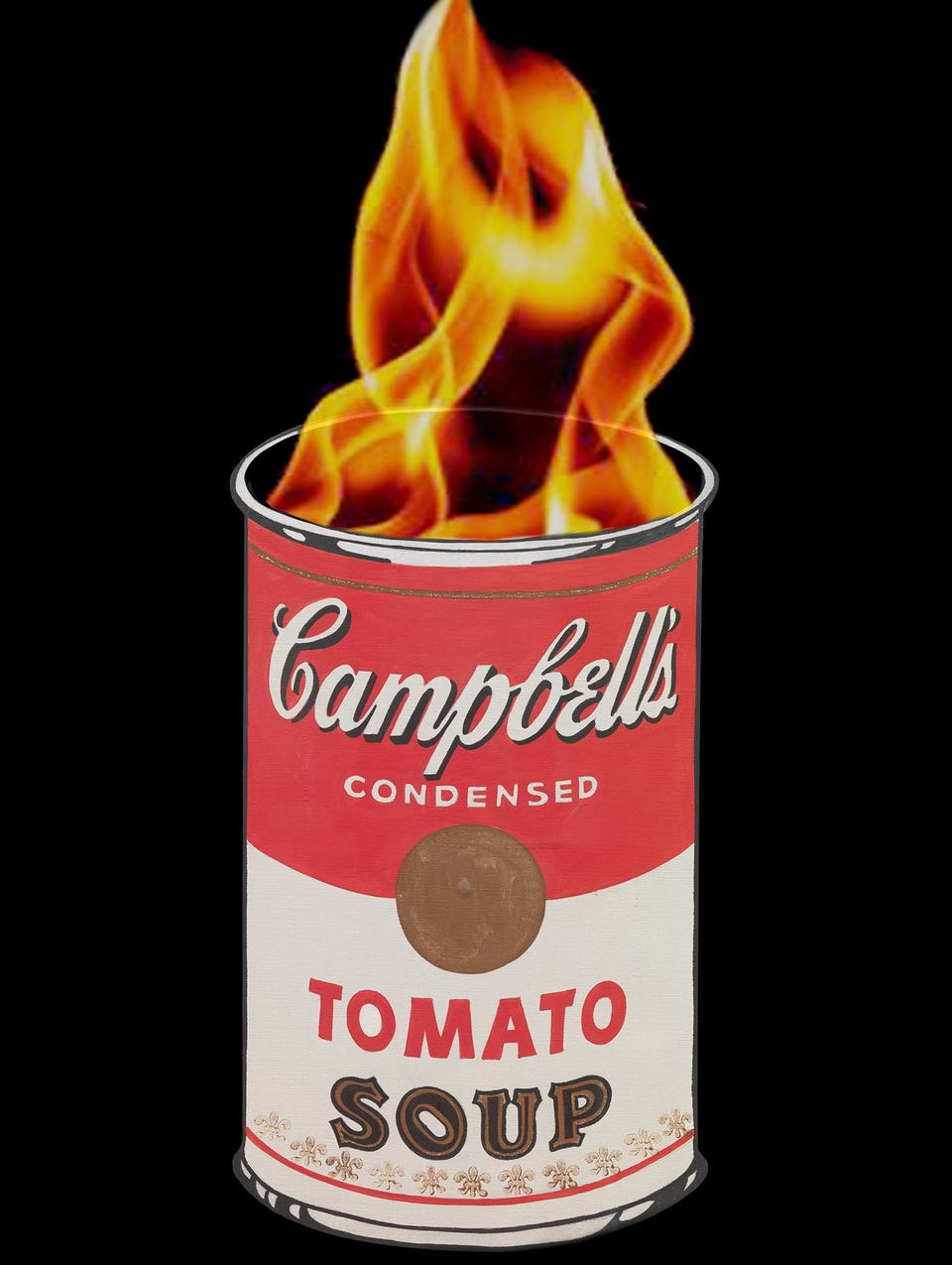It would was impossible to ignore the news from Los Angeles last week. There’s been relentless coverage showing whole suburbs swept away by fire, numerous interviews with affluent middle-class people who’ve lost everything. It’s another of those ‘one-in-a-thousand-years’ events that seems to happen every few months. Under Trump’s version of environmental protection we might expect a further escalation in these oh-so-rare disasters. Just don’t wait for him to pay for assistance or reconstruction. He needs the money for billionaire tax cuts and buying Greenland.
I’ve yet to see anyone speculating about the high-end art that’s been lost during the bombardment of Gaza, but it’s a big consideration in LA. There will be thousands of Californian households the insurance companies had already dumped from their books, leaving people without a financial security net. There will also be numerous properties that have lost valuable works of art. Can you imagine the art collections housed on Pacific Palisades?
This in turn will throw a spotlight on the outrageous, ever-spiralling prices paid by cashed-up collectors for works of contemporary art. Many of these pieces will be valued at current market rates, although they might have been expected to decline over time, as the eye of art fashion moves on. A market that has made the Uber dealers as wealthy as their clients has set an insurance time bomb awaiting a disaster of this magnitude. As Vanity Fair put it: “The damage is utterly uncalculable right now.” I always thought the word was “incalculable”, but maybe American English is different.
From the widespread sympathy extended to Luigi Mangione, who murdered the CEO of a Health Insurance firm in cold blood, it’s clear that insurance companies aren’t winning any popularity contests in the US today. They can be expected to fight every LA claim as hard as possible, but in big cases they won’t be dealing with ordinary people who can be bullied and broken down by the prospect of long drawn-out court proceedings, but with wealthy people employing top law firms.
As the insurance firms are squeezed expect that ordinary people will be squeezed all the harder; that basic insurance premiums will skyrocket; that it will be difficult to even qualify for insurance, let alone pay for it. Everything in American life tends towards widening the chasm between the haves and have-nots, aided and abetted by the Trump-loving have-nots. Soon insurance – the industry that gave gainful employment to figures such as the poet, Wallace Stevens; the composer, Charles Ives; and the linguist, Benjamin Lee Whorf, will be a luxury available only to the wealthy. People will be uninsured, or only partially insured, in line with what they can afford.
What a battlefield lies ahead for the specialist Fine Arts insurers who are facing astronomical payouts. What a tangled mess, just sorting out valuations of what a work is actually worth. Many pieces will have declined in value since first purchase, others will have risen. Either way, the insurer pays only the stipulated value on nominated items. Blanket coverage gets more tricky, as it relies on current market valuations. Anybody who hasn’t kept documentation – or lost it in the fires – will have a fight on their hands.
When it comes to individual artists, many have lost homes and studios, art collections and whole bodies of work. Spare a thought for artist, Kathryn Andrews, who lost everything in a wildfire in 2020, and has now gone through the same ordeal again. She is also keeping tabs of the artists who’ve been hit by the fires, and has already collected more than 90 names.
The New York Times ran a story about an art dealer who had lost millions of dollars’ worth of work by Andy Warhol and Keith Haring, but this is only a taste of what we’ll be hearing in weeks to come. At present the same few stories are being repeated by different outlets, awaiting more comprehensive inventories.
After the devastation it’s anyone’s guess what happens next. A lot of wealthy people will be rebuilding homes and thinking what they want to put on the walls. Some may take a more restrained approach, perhaps because they already have collections in storage. Others will plunge straight in, precipitating high times for dealers and auction houses. The fires have provided the opportunity to update collections, and many will see this as time for a fresh start. If Trump’s tax cuts go through, the really wealthy people will have extra money to spend.
Will collectors forget about a previous season’s hot artists and go looking for new ones? Will they look to buy more ‘blue chip’ works? A lot will depend on the wider economy, and on the way the galleries and auction houses market artists old and new. It’s only too likely that out of the ashes a new art boom will arise.
The art column for The Nightly is taking a break this week. Normal service will be resumed very soon, as the art review is the main game on this site. In the meantime, I’m back in the Australian Financial Review (!!) with a profile of X Zhu Nowell, director of the Rockbund Art Museum in Shanghai, and a rising star in the world of east-west contemporary art.
Conclave is the subject of this week’s film review. The College of Cardinals meets under lock and key to elect a new Pope, and Ralph Fiennes is in charge of proceedings. It proves to be a much harder job than he could have anticipated. After negotiating this labyrinth of ecclesiastical secrets he’d be in good shape to figure out an LA insurance claim.


